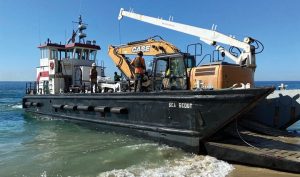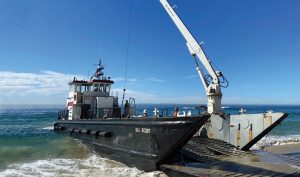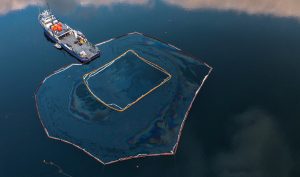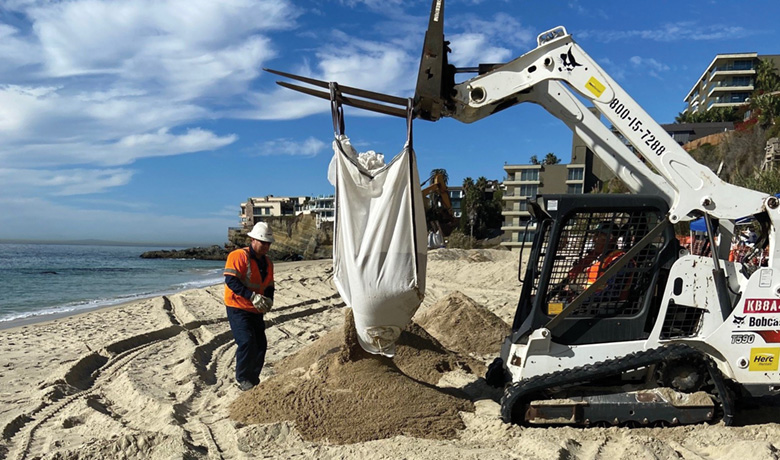
Spill response and recovery are an integral and necessary part of the maritime industry. In spill response we see ghosts of vessels past, consequences of the present and glimpses into the future of industry actions. Understanding how industry experts are managing these situations, as well as how researchers are working to create solutions can better inform planning for future incidents. These three case studies demonstrate adaptation to unconventional spill response and recovery efforts.
Thousand Steps Beach, Orange County, California
Recent headlines on spill response have focused on the multiple beach closures in Southern California caused by an anchor-dragging incident months before the October 2021 spill. One of the more problematic areas of cleanup included the popular surfing location of Thousand Steps Beach in Laguna Beach. Difficult to access using conventional methods, this location has limited approaches by either land or sea due to private homes and lack of roads.
Responses to the incident included experts at Pacific Maritime Group, Inc., said Steve Frailey, the company’s vice president of Government/Military Affairs and Sales, and Travis Stephens, the company’s Long Beach General Manager. Pacific Maritime Group is a subcontractor with ANCON Services, which Stephens and Frailey said applies its expertise to capture and replace diesel fuel-contaminated beach sand.

In order for cleanup to proceed, contaminated sand needed to be removed and clean sand brought into the site—a difficult order without roadways on which to move sand in or out on.
Pacific Maritime Group was able to deploy the Sea Scout, which the company describes as a “former U.S. Navy Landing Craft which has been extensively rebuilt and modified … to haul freight and hazardous waste.”
Using the Sea Scout, both equipment and sand were able to shuttle between sites and staging areas as needed, preventing any damaging delays by bypassing traditional roadway access. The effort was made possible by quick and coordinated teamwork, Stephens and Frailey said.
Pacific Maritime Group continues to support the efforts of fast response to present-day spills using multiple approaches, including the deployment of proposed “specialized skimmers” in areas such as Ballona Creek to prevent water contamination from plastic and debris.
St. Patrick, Kodiak, Alaska
In 1981, the St. Patrick, a fishing vessel, was rendered inoperable near Marmot Island, claiming the lives of 10 members of the 12-person crew. The damaged vessel was towed to Women’s Bay in Kodiak, where it eventually sank to the seafloor in 1989. While not ideal, the vessel and its contents remained largely unchanged for decades until an 8.2 magnitude earthquake struck the Alaskan peninsula in July of 2021. Shortly, thereafter, oil began to leak.
The U.S. Coast Guard contacted service providers on Aug. 5, 2021, after identifying an oil sheen from the air. Containment services were swiftly deployed by Alaska-based subcontractors Paradigm Marine and Alaska Chadux Network which worked in partnership with Global Diving and Salvage of Seattle. The Alaskan teams quickly worked to deploy a containment boom around the wreckage and sorbents within, setting the stage for dive teams to identify the source of the leak.
“Once contained, a Global dive team was dispatched to identify the source of the leak. They discovered several corroded rivets along the hull of the vessel causing pinhole leaks,“ Global spokesman Griffin Cheslow said. “The divers were able to temporarily minimize the leaking with damage control plugs and epoxy until a defueling plan could be established,” Cheslow said.
Due to the age of the wreck, diagrams and information were limited and naval architectural experts were required for support. Finally, Cheslow said, the recovery process could begin.
“Divers bored a hole in the tank using a magnetic drill and began pumping operations, recovering over 4,050 gallons of diesel and black oil until only water was being pumped,” he explained. “Using the 3D imagery generated by the sonar survey and other factors, other tanks and voids were explored and cleared of more oil/fuel pockets.”
Global notes that having onsite response teams at the Pacific Rim Response Center (PRRC) on Kodiak assisted their efforts.

Novel Biosurfactants, Oceanic Arctic
University of Washington graduate student Georges Kanaan has ideas for the future of spill response. Kanaan received the inaugural Leo Cup in 2021, an award from the Leo Maddox foundation through the UW School of Oceanography. It is designed to provide “opportunities for young scientists to pursue innovative solutions that address the impacts of ocean pollution and plastics.”
His project, titled Novel Biosurfactants to Mitigate Oil Spills in Cold Oceans, is being researched under the mentorship of Dr. Jody Deming and Dr. Jodi Young.
Kanaan describes his vision.
“Bioremediation has the potential to be one of our greatest tools: exploring the ways in which processes that already exist in nature can be used to clean up pollution and restore environments,” he said.
This nature-based innovation is driven in part due to conversations surrounding the emerging Arctic.
“The scope of the project was defined by a key fact: that the Northwest Passage is becoming navigable for longer periods of the year due to climate change. This will inevitably lead to a higher risk of oil spills in the Arctic,” Kanaan explained. “Hence identifying arctic bacteria capable of producing compounds that emulsify oil, making it more physically available for natural biodegradation, is the goal of this project.”
While a definite in-demand solution for areas that pose extreme challenges to spill cleanup, his project still has a long way to go before becoming commercial.
“I do not have a timeline for feasibility as the project is still in its infancy,” Kanaan explained. “Currently, my work focuses on identifying compounds produced by a set of Arctic bacteria that show signs that they could emulsify oil.”
Kanaan also noted that there are many steps between identification and commercial scalability, but that doesn’t mean the ideas shouldn’t be invested in and followed.
Kanaan additionally emphasized the need for the industry to continue these quests to become “sustainable and just.”

